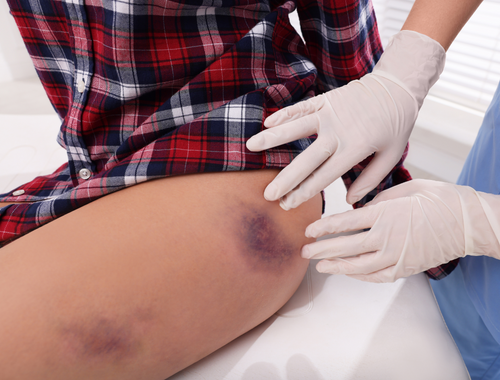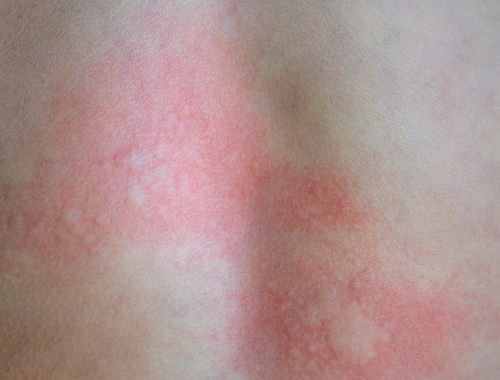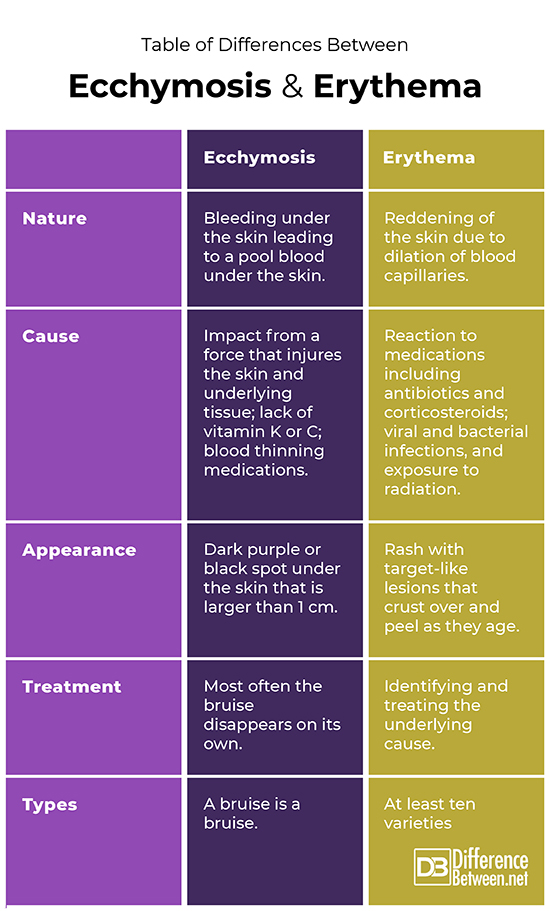Difference Between Ecchymosis and Erythema

Ecchymosis is the medical term for a bruise (Corrinne O’Keefe Osborn). The discoloration of the skin suggests ongoing bleeding underneath the skin, most often the result of an impact injury. Failure of the blood to clot suggests issues with medications such as blood thinners and steroids (Charles Patrick Davis). Erythema, in contrast, is patches of red skin that are result from injury or irritation that causes dilation of the blood capillaries.

Presentation
Ecchymosis occurs when blood vessels near the surface of the skin burst open and leak, trapping the blood beneath the skin in a little pool that that turns the skin purple, black and/or blue. Bruises are common and affect most people, especially on the limbs that are more likely to suffer trauma, and women tend to bruise more often than do men. In addition, many medications can increase bleeding and bruising, including blood thinners, antibiotics, corticosteroids, and dietary supplements (Corrinne O’Keefe Osborn). A lack of vitamins K and C have also been shown to make people more vulnerable to bruising (Brittany Ferri).
Erythema presents as large patches of red skin with lesions. The condition starts with small red spots a few centimeters in size that look like a bulls-eye: a dark red center with a blister of crust surrounded by a pale pink ring and darker outer ring. The lesions may be slightly itchy or uncomfortable, and as they age, they become scaly or peel (James E. Fitzpatrick et al.). Most often, they fade within 2 to 4 weeks. In severe cases, the patches may form large areas that are raw and painful (National Health Service [NHS]). Additional symptoms may include fever, painful joints, headache, mouth and genital sores, swollen lips as well as sore eyes, blurred vision, and sensitivity to light.
Many different varieties of erythema have been identified. The most common is erythema multiforme (Michelle Llamas) which presents as a rash that starts suddenly, usually on the hands and feet if it is minor. If it spreads to the other parts of the body, where the lesions are more serious and extensive. It is considered erythema multiforme major. Erythema nodosum, presents as red, tender bumps on the shins. Erythema marginatum typically appears on the limbs and trunk. Erythema toxicum, which affects 40‒70 percent of full-term newborns, gives infants a flea-bitten appearance. Erythema infectiosum is a mild face condition and more common in children. Erythema migrans occurs in people with early Lyme disease about seven days after being bitten by an infected tick and may gradually expand up to about 12 inches across. Erythema ab igne is caused by repeated exposure to infrared radiation or direct heat to the skin. Sources of heat include warm water bottles, heating pads, laptop computers, space heaters, and the sun. Erythema annulare centrifugum most often affects the thighs.
Erythema is not infectious, and research has identified a wide variety of causes, but it most often considered to be a reaction to medicines such as antibiotics, non-steroidal anti-inflammatory drugs, and anticonvulsants (NHS); a viral infection with herpes simplex types 1 and 2 or the parvovirus B19; a bacterial infection such as streptococcus; a reaction to vaccines (Michelle Llamas), and/or the product of an underlying condition like diabetes, inflammatory bowel syndrome, and liver toxicity.
Treatment
Generally, ecchymosis is resolved without treatment within two to three weeks (Corrinne O’Keefe Osborn) as the body reabsorbs the blood that has pooled beneath the skin and the bruise goes from red or purple, to black or blue, to brown, and then yellow.
Treatment for erythema is aimed at addressing the underlying cause, which may mean ceasing medications and the use of antihistamines and steroid creams. Complications include sepsis, cellulitis, and inflammation of the internal organs (NHS).
Table of differences between ecchymosis and erythema

Summary
Both ecchymosis and erythema are skin conditions, but while ecchymosis is bleeding under the skin due to traumatic force and most often resolves without treatment, erythema is lesions caused by the dilation of the blood capillaries in the skin in response to medications, viral and bacterial infections, and exposure to radiation. Treatment involves addressing the underlying condition.
FAQ:
What is erythema ecchymosis?
Erythema ecchymosis is a type of bruise, or dark purple spot on the skin larger than 1 cm caused by a blow, bump, or fall. It is the result of blood leaking from blood vessels and pooling under the skin (Stephanie Watson).
What is the difference between a bruise and ecchymosis?
Hematoma is a solid swelling of clotted blood in the tissue, whereas ecchymosis is a skin discoloration that is caused by bleeding underneath the skin (Charles Patrick Davis).
Is ecchymosis the same as purpura?
Purpura, also called blood spots or skin hemorrhages (Amber Erickson Gabbey), have a diameter between 4 and 10 millimeters (Corrinne O’Keefe Osborn) and look more like a rash than a bruise or lesion. They are caused by small blood vessels bursting under the skin. Unlike ecchymosis, which is caused by injurious force, purpura are generally caused by infections, medications, and blood clotting problems.
What is the difference between erythema and redness?
Redness is the quality of an object being a particular color and is a symptom of numerous skin conditions (Lauren Krouse) Abnormal redness or flushing is due to inflammation of the skin due to vasodilation, for example, blushing. Erythema has various causes which may include reactions to medications, viral and bacterial infections, and exposure to radiation.
How do you describe ecchymosis?
Ecchymosis turns the skin dark purple, and as it heals, the bruise may turn green, yellow, or brown. The discoloration occurs when blood vessels bleed under the skin.
What is erythema caused by?
Erythema is an inflammatory skin condition caused by environmental factors including medications, infection by virus or bacteria, or overexposure to the sun (A. J. Moy and Tunnell) as well as underlying chronic conditions such as diabetes, inflammatory bowel syndrome, and liver toxicity (NHS).
- Difference Between Ecchymosis and Erythema - August 15, 2022
- Difference Between Autobiographical Memory and Episodic Memory - August 1, 2022
- Difference Between Biological Drive and Social Motive - July 30, 2022
Search DifferenceBetween.net :
Leave a Response
References :
[0]Davis, Charles Patrick. Hematoma vs Ecchymosis: Differences and Similarities. eMedicinehealth. 2022. https://www.emedicinehealth.com/hematoma_v_ecchymosis/article_em.htm
[1]Ferri, Brittany. An overview of Ecchymossis. Verywell Health. November 27, 2021. https://www.verywellhealth.com/ecchymosis-4773870.
[2]Fitzpatrick, James E., Whitney A. High, Kyle, W. Lamar. “Chapter 4—Diffuse or Reticulated Erythema.” In Urgent Care Dermatology: Symptom-Based Diagnosis, 2018, pp. 51-62. https://doi.org/10.1016/B978-0-323-48553-1.00004-5.
[3]Moy, A.J. and J.W. Tunnell. “Chapter 17 ‒Diffuse Reflectance Spectroscopy and Imaging.” Imaging in Dermatology, 2016, pp. 203-215. https://doi.org/10.1016/B978-0-12-802838-4.00017-0
[4]Watson, Stephanie. What is Ecchymosis? January 18, 2022. https://www.webmd.com/skin-problems-and-treatments/ecchymosis#:~:text=That%27s%20the%20medical%20term%20for,top%20layer%20of%20your%20skin.
